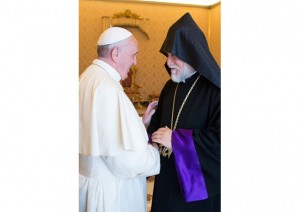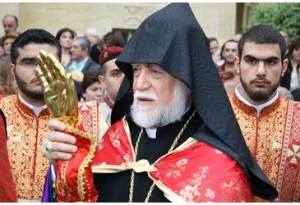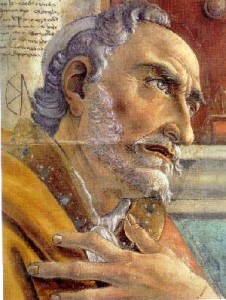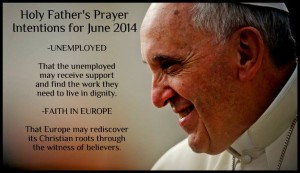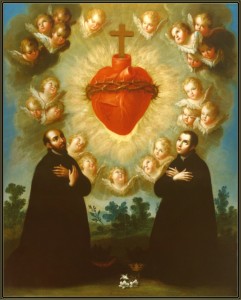 There are a number of things which distinguish Catholic piety and the is celebrated each year by the devotion to the Sacred Heart of Jesus is one of those marks. Let me be quite clear: one’s devotion to the Sacred Heart of Jesus is not one devotion among many. The devotion to the Sacred Heart of Jesus is the center, the source and summit, of our Catholic faith. It is what distinguishes us from non-believers but most importantly it proclaims from the rooftops what it means to be a person fully alive in God and seeking life with God in heaven.
There are a number of things which distinguish Catholic piety and the is celebrated each year by the devotion to the Sacred Heart of Jesus is one of those marks. Let me be quite clear: one’s devotion to the Sacred Heart of Jesus is not one devotion among many. The devotion to the Sacred Heart of Jesus is the center, the source and summit, of our Catholic faith. It is what distinguishes us from non-believers but most importantly it proclaims from the rooftops what it means to be a person fully alive in God and seeking life with God in heaven.
What does our devotion to the Sacred Heart teach us? This devotion is about the intimacy between Jesus and us as an intimate union of the heart.
What hear revealed in sacred Scripture is that the work of the Lord is effect a change in our heart opening in us the capacity to love Him as He loves, by loving world with the Eucharistic heart of Jesus.
In 2014, the Church honor the Lord’s Love for Humanity 19 days after Pentecost Sunday on June 27.
As you know, each month of the calendar year is dedicated to some aspect of the Paschal Mystery: June is dedicated to the Heart of Jesus. Over the two millennia of the Church’s existence some aspect of the Sacred Heart’s devotion is made known, often through private revelations: we can thing of Saint Gertrude, Saint Margaret Mary Alocoque, Saint John Vianney, Saint Faustina, Blessed Francisco de los Hoyos, among others. One ought not forget that Father Karl Rahner and the Servant of God Father Pedro Arrupe had keen devotions to the Heart of Jesus. All these people call out for us to reconcile out life with that of the Lord’s promises.
Probably the most known devotee to the Heart of Jesus is Saint Margaret Mary –with her spiritual father the Jesuit Saint Claude la Colombiere– in Paray-le-Monial, France, 1673.
Prayer to Jesus the Christ has a particular character because He is the Son of God, the Second Person of the Blessed Trinity: the Good Shepherd, brother, friend, the God-man totally in love with each one of us, our Lord and Savior, our King, etc. So, Jesus is not as good as Buddha. The Devotion to the Sacred Heart of Jesus is about the person of Jesus Himself.
Our meeting the Sacred Heart of Jesus in prayer is an encounter with the divine-man who heals, teaches, and conquers evil in his essential being as the person who, first and foremost, loves. Jesus does all these things because of His love. In art we see this portrayed in the image of the heart pierced with Love pouring out all kinds of grace from His Heart we call Sacred.
The object of devotion of the Sacred Heart is the real, physical heart of Jesus, which is sacramentally present, really and truly, in the Holy Eucharist. The Eucharist is Christ’s body and blood given for us on the cross, the body that contained His Sacred Heart.
The Heart of Jesus is about the Lord’s Presence, and not a project, a particular work, no matter how good it is. This is something the head of Communion and Liberation, Father Julián Carrón has been teaching us with great force. The Presence of Jesus is in our total life– our joys and sufferings, our work and leisure, our heart and mind, with our friends, family and enemies: absolutely nothing is left out.
How can we remind ourselves of this Presence? A few good options: daily prayer (uniquely in the Litany of the Sacred Heart), a weekly hour hour in front of the Eucharistic Lord (in the Sacrament); making the Enthronement of the Sacred Heart in the home, observing the Nine Consecutive First Friday Masses, making a personal Consecration to the Sacred Heart, and reception of Holy Communion in with the intention of making reparation for those who do not love Him, especially priests. But you can adopt very simply the Little Flower’s approach: do all things with love.
In these blog pages I speak of the sacrament of the Church as the Lord’s way of being present to the world today. This idea follows, among many reasons, from the thought of Saint Leo the Great who reminded us that what was seen in the Savior is now seen His Church. The sacramentality offered to us in the 7 sacraments is about a certainty in the Lord’s desire for intimacy with us. But his intimacy requires us to cooperate with the sacramental graces to remain united to His Sacred Heart. My dear friend French Jesuit Father Bertrand de Margerie (+2003) always emphasized that the intimacy we ought to have with the Lord is brought about through one’s frequent confession and reverent reception of Holy Communion which he bases his teaching on Pauline theology.
In the end, one’s devotion is about answering who Jesus is. Other questions: do you expect to meet Christ? Do you believe that Jesus is the Sole Mediator? Do you personally embody of the virtue (holiness) of the Sacred Heart? Do you attend to the words of consecration prayed by the priest at Mass? Do you really, substantially believe that Jesus saves souls with his love, having mercy on each and every sinner? Do you believe that we are meant to be with God the Father in heaven?
 In this octave of the Ascension, and just before the great solemn feast of Pentecost, I thought I might share with you a 2005 video of the building of the Monastery of Novy Dvur (Czech Republic). To me, this community of Trappist monks is another great example of faith in action, of seeing the human person in action so that God may be glorified.
In this octave of the Ascension, and just before the great solemn feast of Pentecost, I thought I might share with you a 2005 video of the building of the Monastery of Novy Dvur (Czech Republic). To me, this community of Trappist monks is another great example of faith in action, of seeing the human person in action so that God may be glorified.